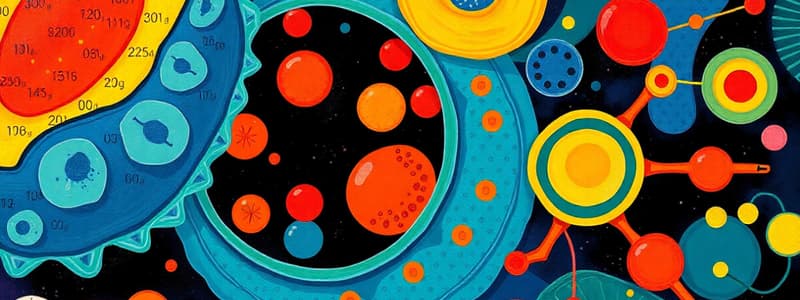Podcast
Questions and Answers
Which of the following components is NOT part of the protoplasm?
Which of the following components is NOT part of the protoplasm?
- Nucleoplasm
- Cell membrane (correct)
- Cytoplasm
- Colloid material
What is the primary role of water in the living cell?
What is the primary role of water in the living cell?
- To store genetic information
- To serve as a solvent and facilitate transport (correct)
- To generate cellular energy
- To provide structural support
Which of the following correctly describes an acid?
Which of the following correctly describes an acid?
- A substance that donates a hydrogen ion (correct)
- A substance that releases hydroxide ions
- A substance that donates a hydroxide ion
- A substance that maintains a neutral pH
What does a pH of 7 indicate?
What does a pH of 7 indicate?
What is the typical pH of arterial plasma?
What is the typical pH of arterial plasma?
How does the reaction between an acid and a base typically affect pH?
How does the reaction between an acid and a base typically affect pH?
Which property of water allows it to stabilize cellular temperature?
Which property of water allows it to stabilize cellular temperature?
What role do buffers play in biological systems?
What role do buffers play in biological systems?
Flashcards
Inorganic substances
Inorganic substances
Non-living chemical compounds found in cells, including water, carbon dioxide, oxygen, and salts.
Water's high heat capacity
Water's high heat capacity
Water's ability to absorb a lot of heat without a large temperature change.
Water's high heat of evaporation
Water's high heat of evaporation
The large amount of energy needed to change liquid water to water vapor.
Water as a solvent
Water as a solvent
Signup and view all the flashcards
Acid
Acid
Signup and view all the flashcards
Base (or Alkali)
Base (or Alkali)
Signup and view all the flashcards
pH Scale
pH Scale
Signup and view all the flashcards
Buffer
Buffer
Signup and view all the flashcards
Study Notes
Cell Components
- Living cells consist of protoplasm, surrounded by a plasma membrane
- Protoplasm is the living material of the cell (cytoplasm and nucleoplasm)
- Protoplasm is a colloid (chemical molecules: inorganic and organic)
Inorganic Substances
- Four key inorganic substances in cells:
- Water
- Carbon dioxide
- Oxygen
- Salts
Importance of Water
- Most abundant compound in the body (70-90%)
- Carries substances to and from cells
- Enables absorption, exchange, secretion, and excretion
- Properties:
- High heat capacity
- High heat of evaporation
- Solvent (95% of cellular water is free)
Water Molecules and Solutions
- Water molecules have positive and negative poles
- Solutions contain dissolved substances in water
- Glucose in solution
- Sodium chloride in solution (illustrated)
Acids, Bases, and Salts
- Acids: Donate hydrogen ions (H+)
- Example: Hydrochloric acid (HCl) in stomach
- Bases: Accept hydrogen ions (OH-)
- Also called alkalis
- Example: Sodium hydroxide (releases hydroxide ions)
- Reaction of acid and base: Produces salt and water
- pH Scale: Measures acidity or basicity (alkalinity)
- Ranges from 0 to 14
- 7 is neutral (equal hydrogen and hydroxide ions)
- Below 7 is acidic (higher hydrogen ions)
- Above 7 is basic (higher hydroxide ions)
- Blood pH is normally 7.40
Buffers and Salts
- Buffers: Maintain pH within normal limits
- Important for health
- Blood pH is normally about 7.4 (slightly alkaline)
- Salts: Electrolytes; Cations (not hydrogen) and Anions (not hydroxide)
- Essential for metabolic processes, cell transport, muscle contraction, and nerve impulses
- Ions (Cl-, Na+, K+, Mg++) are important in maintaining osmotic pressure, acid-base balance.
- Intracellular fluid has high K+ and Mg++, while extracellular fluid has high Na+ and Cl-
- Hydrogen ions (H+) are more excreted extracellular, while bicarbonate ions (HCO3-) are more intracellular.
Studying That Suits You
Use AI to generate personalized quizzes and flashcards to suit your learning preferences.
Related Documents
Description
Explore the foundational elements of cell biology, focusing on cell components, especially protoplasm and the vital role of inorganic substances like water, acids, and bases. This quiz covers essential topics for understanding cellular structure and function.




